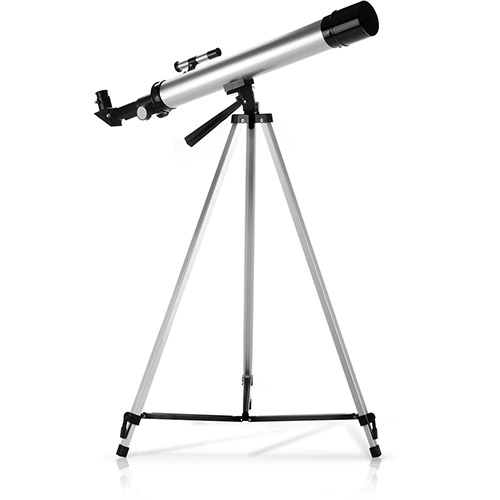Quero iniciar-me na Astronomia e, como não disponho de muitos recursos, gostaria de saber se com um telescópio como o da foto poderei ver a Lua e Saturno.
 Com o telescópio que me apresentou consegue ver a Lua e Saturno para além de Vénus, Marte e (um pouco mais difícil) Úrano e Neptuno. Poderá ver também diversas estrelas, enxames de estrelas e nebulosas. Embora seja um telescópio relativamente "fraco" dá para fazer umas coisas. Chamo, no entanto, a atenção para o seguinte:
Com o telescópio que me apresentou consegue ver a Lua e Saturno para além de Vénus, Marte e (um pouco mais difícil) Úrano e Neptuno. Poderá ver também diversas estrelas, enxames de estrelas e nebulosas. Embora seja um telescópio relativamente "fraco" dá para fazer umas coisas. Chamo, no entanto, a atenção para o seguinte:
1) para se iniciar na Astronomia o melhor, ainda antes do telescópio, é arranjar uma carta celeste e com os seus próprios olhos começar a identificar as estrelas no céu. As mais brilhantes, as constelações mais importantes, os planetas (só Úrano e Neptuno não se podem ver a olho nu). Por exemplo aqui pode encontrar mapas de todas as 88 constelações. Algumas não são visíveis nesta época do ano e outras não serão visíveis da sua zona geográfica. Pode também instalar o programa Stellarium que é gratuito e começar a navegar pelo céu:
http://stellarium.en.softonic.com/
2) Caso adquira este ou outro telescópio apenas o poderá utilizar para observação do Sol caso este venha devidamente equipado para tal. Deverá possuir um filtro solar ou um alvo para a projeção da imagem do Sol e seguir rigorosamente todas as instruções do manual. EM CASO ALGUM DEVERÁ OLHAR DIRETAMENTE PARA O SOL PELO TELESCÓPIO - AS LESÕES NA VISÃO PODEM SER IRREVERSÍVEIS (aliás nem a olho nu devemos olhar para o Sol diretamente).
I want to start in Astronomy, and I don't have a lot of resources. I would like to know if with a telescope like in the figure attached, I could see the Moon and Saturn.
With the telescope that you showed me, you can see the Moon and Saturn, as well as Venus, Mars and (more difficult) Uranus and Neptune. You can also see several stars, star clusters and nebulae. Although it is a relatively "weak" telescope, it can do quite a few things. However, I call your attention to the following notes:
1) To get started on Astronomy, the best thing, even before a telescope, is to get a celestial chart and, with your own eyes, start to identify the stars in the sky. The brightest, most important constellations, the planets (only Uranus and Neptune can't be seen with the naked eye). For example, here (https://astro.web.uma.pt/Astronomia/Observ_mes/index.htm), you can find maps of all 88 constellations. Some are not visible at this time of year and others will not be visible from your geographic zone. You can also install the free Stellarium program and start navigating the sky:
http://stellarium.en.softonic.com/
2) If you purchase this or another telescope, you will only be able to use it for observing the Sun if it is properly equipped for that. You must have a solar filter or a target for projecting the image of the Sun and strictly follow all the instructions in the manual. UNDER NO CIRCUMSTANCES SHOULD YOU LOOK DIRECTLY AT THE SUN THROUGH THE TELESCOPE - VISION DAMAGE CAN BE IRREVERSIBLE (in fact, we shouldn't even look at the Sun directly with the naked eye, much less this way).
 Com o telescópio que me apresentou consegue ver a Lua e Saturno para além de Vénus, Marte e (um pouco mais difícil) Úrano e Neptuno. Poderá ver também diversas estrelas, enxames de estrelas e nebulosas. Embora seja um telescópio relativamente "fraco" dá para fazer umas coisas. Chamo, no entanto, a atenção para o seguinte:
Com o telescópio que me apresentou consegue ver a Lua e Saturno para além de Vénus, Marte e (um pouco mais difícil) Úrano e Neptuno. Poderá ver também diversas estrelas, enxames de estrelas e nebulosas. Embora seja um telescópio relativamente "fraco" dá para fazer umas coisas. Chamo, no entanto, a atenção para o seguinte: